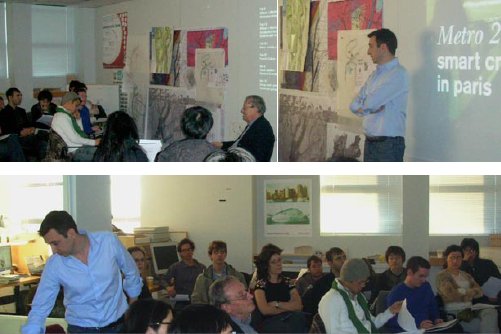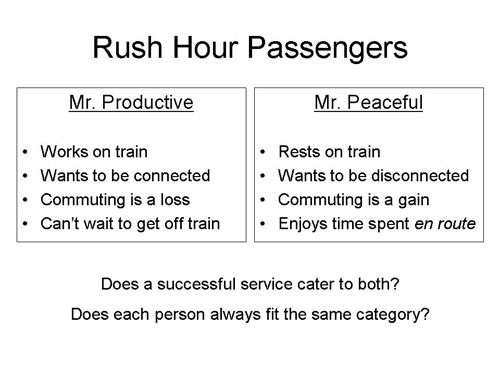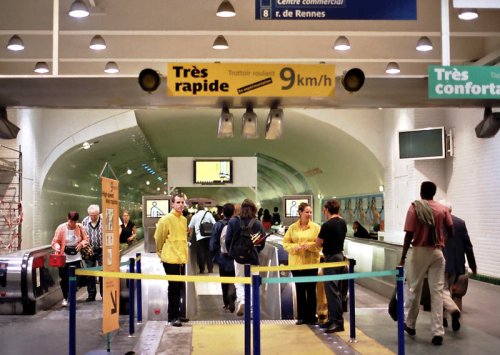Rethinking the Paris Metro by Anthony R. '09
I'm taking an awesome grad class that includes spring break in Paris. (Yeah, they're paying.)
One of my five classes this term is sponsored by RATP, the metropolitan transit authority of Paris. It’s a graduate design workshop in the School of Architecture and Planning’s Mobile Experience lab, and I might turn it into a for-credit UROP as well.

RATP has asked us to consider new uses and features for the Paris metro (subway) system — ways to make it not just a simple means of transport, but an integral part of community and leisure. Everything’s becoming automated — ticket sales, even the operation of the trains — and new space is opening up where those tasks were previously performed manually. What can be done with a ticket booth now that people buy from machines? Who is taking the metro, what kinds of things appeal to them, and how do they interact with their fellow passengers and the surroundings? Plus, once staff members are no longer needed for newly automated tasks, how can they be put to use in new and innovative ways?

Yeah, that was an intro slide I put together…
Anyway, once we identify potential new services and prepare our recommendations, the authority’s research and development staff will be hosting us in Paris. The trip will allow us to validate what we’ve found and also do some on-site research, exploring the metro and its integration into Parisian life.
RATP is known for experimenting with new and innovative concepts, including a “faster” moving sidewalk (no joke…):

This thing is called the TRR, or trottoir roulant rapide, and is being tested at Paris’ Gare Montparnasse as a possible time saver in that long tunnel. Apparently you stand on a slower portion for a few seconds, keep your feet straight, and it glides you onto the fast section so you don’t fall. Wikipedia says, “At first it operated at 12km/h but too many people were falling over so the speed was reduced to 9km/h. It has been estimated that commuters using a walkway such as this twice a day would save 11.5 hours a year.”
11.5 hours a year saved? But what happens when you get to the end of the trottoir and have to wait a minute for your train, or for escalator congestion? Well, I’m sure they’ll figure it out! (or maybe I should include that in my notes… hmm…)
Hong Kong in Southern China has improved the efficiency of ticket distribution by getting rid of tickets all together. Utilizing Octopus RFID cards, similar to a credit card, you can tap the Octopus card against the gateway’s card reader and it will automatically deduct the fare from your account. Automated booths range from booths that can check your card’s account info, how much money it has and history of pass transactions to big booths where you can update,cash, or debit.
I’m sure Paris adopted this years ago but Hong Kong was the first to introduce it.
you could serve both categories by separating them. you could “make” business cars wich would cost more(special tickets) and have internet access, telephone lines, news papers, power supply for laptops,… that way people who don’t want to “waste time” could work on their way to the office price should be high enough so that the business car isn’t crowded, because noone can work if they don’t have enough room to use a laptop
price should be high enough so that the business car isn’t crowded, because noone can work if they don’t have enough room to use a laptop 
funny you mention that – that was one of my initial ideas
cool i’d definitely like to know more about the solution you decide to go with. solving practical problems like this one is fun :D
i’d definitely like to know more about the solution you decide to go with. solving practical problems like this one is fun :D
Sh1fty, those were my immediate thoughts. Of course, it would be extended into the “Mr. Peaceful” realm as well; outfit the train with plush seats, relaxing interior designs, etc. Create environments that are suited to each personality (the concept could be applied to the metro station itself, as well).
Cool class.
maybe you could borrow Google maps technology to create an interactive system which they could access from cell phones/blackberry/iPhone to figure out the shortest route from their current location to their destination. Based on their previous choices, the system would know whether it should recommend a shorter, more expensive route or a longer, more scenic one.
because it would inform the user about trade fairs, shopping sales or any event relevant to them it would become ‘an integral part of community and leisure’
J’espère que vous vous amusez avec le trottoir roulant rapide à Paris! Moi, je vais en France cet été aussi. Mais pour spring break, je visite le MIT!
[A nifty online translator might be useful. MIT students like puzzles, right? =D]
pas de probleme – je suis le cours du Francais IV ce semestre et je vous comprends bien
Wow, that’s a brilliant class. Are there many more classes which have this sort of real life application?
I love the London Underground it’s definitely the best way to get round London.
Just another piece of information to add to the discussion: In Singapore, there is this electronic card similar to the Octopus card, which is commonly used in buses, trains and certain fast-food outlets. The automated booths are there too. You can also find a moving sidewalk in one train station.
Anthony- I can see two consequences to your proposal of having different cars for different commuters. The downside is the non-business people will have to suffer more congestion. The upside: the extra revenue gained from the ‘business’ cars will hopefully go into alleviaing the transportation costs of the non-business people.
Karen- Can you elaborate more on the MRT in Taipei?
As for me, where I live in the world, people look so frustrated and drained of energy when they board the trains after work. It may be lovely to have the trains play some soothing music or spray out mists of sweet perfume into the air. There are two problems though: firstly, music and scents are sometimes appreciated diiferently by different people; second, the extra costs will again be passed onto the commuters. Well, I guess there is nothing better than a personal ipod at the moment.
Thanks for all your insightful comments, guys!
Chessy – yes, though I’d argue that most are graduate classes. Undergrad stuff is designed to provide a foundation — so a great way to do real-life application is to find a UROP or just a job on the side…
Daisy – the folks who don’t pay for the better seating would likely resent the reduced capacity, it’s true. Something to consider is the platform lengths and whether an extra car is an option…
platform lenght doesn’t matter if you make the last car as an extension to the one before it. it wouldn’t have doors leading to the platform but only to the cars in front and a possible car behind it(if you need more capacity). Chessy’s post reminded me of this song: Amateur Transplants – London Underground :D
What if everyone had a jet pack… or there was a giant catapult? hmm…
seriously though, you know what would be useful for the train itself, if they said how many people were actually in each car at any given moment, or how many seats are available in each car – could see that being done with LED displays and some sort of sensor
idk just a thought, could save some claustrophobics
I just have to say, living near Taipei – I LOVE their MRT. But then, I don’t know much about other cities’ transportation systems.
sounds interesting — and I’d like to try a walk on that moving sidewalk – reminds me of the thing in airports – I can see how people might trip, though :D
well… here in delhi, we have a very modern mass transit system in the form of delhi metro… its undergoing extension and maybe you could get some really handy ideas from there as it has been built very recently and some of the finest engineers in india are involved in the project… i got some stuff from wikipedia… maybe you could take a look at it…!!! and some of the stations have been decrated by murals contributed by students from delhi university… it makes the whole station look aesthetically beautiful…!!! maybe something for the paris stations would be good… BTW, i’ve seen one of the stations form my hotel room… thats the closest i’ve been to paris metro… n disneyland has those sidewalks… i dunno their speed though…!!!
Delhi Metro customers have the following choices for the ticket purchase.
Smart card: These cards are most convenient for the frequent commuters. Valid for one year, these travel cards are available in the denominations of Rs. 50, Rs. 100, Rs. 200 and Rs. 500. 10% bonus is given on each recharge or new card. A deposit of extra Rs.100 needs to be made before buying a new card.
Tourist card: These cards can be used for unlimited travel over short periods of time. There are two kinds of tourist cards – 1 day and the 3 day. Cost of 1-day card is Rs. 70 and 3-day card is Rs. 200.
Token: These tokens are valid only for a single journey on the day of purchase and the value depends on the destination. Fares are decided based on the destination station using the token table.
Blue and Red Tokens are for a single journey only, whereas Green Tokens are for those who need to change trains.
ohhh… n BTW, 1 Dollar is approximately equal to 50 Rupees… (45 Rupees to be precise)
I like the idea about having a separate “business” car, but what if more people than what you can fit in it want to get in? I guess then you’d have to start making reservations, and it’s kind of tough to have to make one in order to use the car during rush hours… People would definitely get pissed if they had to wait for the next train in order to use the car or simply have to get on the “relaxing” part of the train (which is kinda noisy by comparison).
Then you have the other end of the rope, what if the “relaxing” cars are too full and the business cars can still fit more people bc it’s down time and the business people are at work? (This seems unrealistic, but I think of every possibility there is.) The train should travel with the maximum amount of people it can fit, so then I guess it’d actually end up being more expensive to have the business cars empty. So I think the perfect thing would be to have all cars be the same, the way it is now, the only thing is that i’d have the internet and whatever else in every seat, and to use them you’d have to drop some coins/swipe a credit card to pay for it. Those who want to be alone and that would pay extra for the business car shouldn’t even be taking the metro, because everybody knows it’s hectic. They should be taking taxis!
44.2145 to be more precise